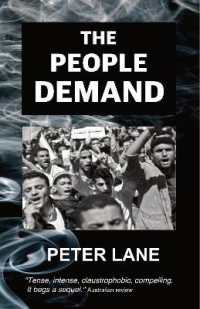- ホーム
- > 洋書
- > 英文書
- > Business / Economics
Full Description
First published by Ravan Press in 1985, Cast in a Racial Mould was a pioneering book. It is now republished by Wits University Press with a new foreword by Michael Burawoy and with support from the National Institute for the Humanities and Social Sciences.
Entering what Marx called the hidden abode of capitalism; the labour process; this book analyzes the nature of work and worker resistance in the metal industry which lies at the core of South Africa manufacturing industry. In an introductory chapter Webster points out that most studies of the labour process have neglected worker resistance. He challenges Braverman depiction of mass production as a juggernaut which inherently imposes progressively tighter controls on workers, and points to two forms of worker resistance which have been important in the history of South Africa foundries.
Discussing the first of these in Part I, he shows how resistance to deskilling on the part of white craft moulders gave rise to a distinctive racial hierarchy of control in the foundries. Using race as a last line of defence against machinofacture assault on their craft privileges, the white moulders effectively became supervisors of semi-skilled black labour;The collapse of this form of control was precipitated by the rise, in a South African foundry context, of the second form of resistance ; increasingly confident bargaining by black semi-skilled workers in the wake of mechanization and the emergence of independent black unions. This is the focus of Parts II and III of the book. The onset of popular struggle in the townships from 1976 onwards forced the state, through a process that began with the Wiehahn and Riekert commissions, to embark on an attempt to incorporate black unions in a deracialized industrial relations system. Webster analyzes the interplay between the transformation of the labour process and the crisis in the system of racial capitalism as a whole to show how worker organizations, in resisting the state incorporative strategy, have begun to develop a working class.
Contents
Foreword to this Edition by Michael Burawoy
Acknowledgements
List of Abbreviations
Preface
Chapter 1 Introduction: Class Struggle in the Foundry
Part 1 The Colour of Craft
Chapter 2 The Heyday of the Labour Aristocrat: The Stage of Manufacture, 1896-1930
Chapter 3 Contesting Skill: Deskilling and the Transition to Machinofacture
Chapter 4 The Theory and Practice of Taylorism in the Early Post-War Period
Chapter 5 From Craft to Colour: The IMS and Job Protection, 1944-1968
Part 2 The Crisis of Control in the Labour Process
Chapter 6 Managerial Resistance to Black Unions, 1973-1977
Chapter 7 Opening the Closed Unions: Restructuring the Racial Division of Labour
Chapter 8 The International Factor: The IMF in South Africa, 1974-1980
Part 3 The Experiment Begins: The Search for a New Form of Control in the Workplace
Chapter 9 Workers Divided: Labour Market Segmentation in the Foundry
Chapter 10 Reform from Above: First Steps in the Deracialization of the Industrial Council System
Chapter 11 The Challenge from Below: The Rise of the Shop Steward Movement
Chapter 12 Cast in Racial Mould: The Birth of a Working-Class Politics
Bibliography
Index
Photographs between pages 158 and 159








